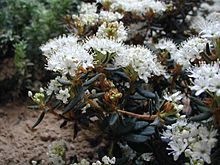Rhododendron tomentosum
| Marsh Labrador tea | |
|---|---|

| |
| R. tomentosum in flower | |
| Scientific classification | |
| Kingdom: | Plantae |
| Clade: | Tracheophytes |
| Clade: | Angiosperms |
| Clade: | Eudicots |
| Clade: | Asterids |
| Order: | Ericales |
| Family: | Ericaceae |
| Genus: | Rhododendron |
| Species: | R. tomentosum
|
| Binomial name | |
| Rhododendron tomentosum Harmaja
| |
| Synonyms[1] | |
|
List
| |
Rhododendron tomentosum (syn. Ledum palustre), commonly known as marsh Labrador tea, northern Labrador tea, marsh rosemary[2] or wild rosemary, is a flowering plant in the subsection Ledum of the large genus Rhododendron in the family Ericaceae.
Description
[edit]It is a low shrub growing to 50 cm (rarely up to 120 cm) tall with evergreen leaves 12–50 mm long and 2–12 mm broad. The flowers are small, with a five-lobed white corolla, and produced several together in a corymb 3–5 cm diameter. They emit strong smell to attract bees and other pollinating insects.
Distribution and habitat
[edit]It grows in northern latitudes in North America, Greenland, Canada, and Alaska, in Europe in the northern and central parts, and in Asia south to northern China, Korea and Japan. It grows in peaty soils, shrubby areas, moss and lichen tundra.
Chemical compounds
[edit]All parts of the plant contain poisonous terpenes that affect the central nervous system. First symptoms of overdose are dizziness and disturbances in movement, followed by spasms, nausea, and unconsciousness.[citation needed] Among the plant's terpenes is ledol, a cyclic alcohol with deliriant effects, although poisonous in large doses.[3][4]
Similar species
[edit]This species is not to be confused with the traditionally-used one Rhododendron groenlandicum, found throughout Northern North America.
Uses
[edit]Herbal medicine
[edit]Rhododendron tomentosum is used in herbalism to make an herbal tea called "Labrador tea".[5] However, no material benefit has been documented in any properly controlled study.[6]
Other uses
[edit]Marsh Labrador tea has traditionally been used as a gruit in brewing beer in the Middle Ages.[7] Due to its strong fragrance, it has also formerly been used as a natural deterrent against clothes moths, also mosquitos and bugs in general, in Scandinavia and in Eastern Europe.
References
[edit]- ^ "Rhododendron tomentosum Harmaja". Plants of the World Online. Board of Trustees of the Royal Botanic Gardens, Kew. 2017. Retrieved 12 December 2020.
- ^ Judzentiene, Asta (2020). "Review: Marsh rosemary (Rhododendron tomentosum Harmaja (ex Ledum palustre Linn) growing in Lithuania) essential oils and their properties". Chemija. 31 (4): 269–277. doi:10.6001/chemija.v31i4.4324.
- ^ Duke, James A. (2017-12-06). "Handbook of Phytochemical Constituents of GRAS Herbs and Other Economic Plants". Routledge. pp. 1–654. doi:10.1201/9780203752623-1. ISBN 9780203752623. Retrieved 2021-11-29.
{{cite book}}: Missing or empty|title=(help) - ^ Herbs of the Northern Shaman: A Guide to Mind-Altering Plants of the Northern Hemisphere.
- ^ "Labrador Tea: Health Benefits, Side Effects, Uses, Dose & Precautions". RxList. Retrieved 2024-05-02.
- ^ "Labrador tea | Description, Species, & Facts | Britannica". www.britannica.com. Retrieved 2024-05-02.
- ^ Buhner, Stephen (1998). Sacred and Healing Herbal Beers. Boulder, CO: Siris Books. p. 169. ISBN 978-0-937381-66-3.
